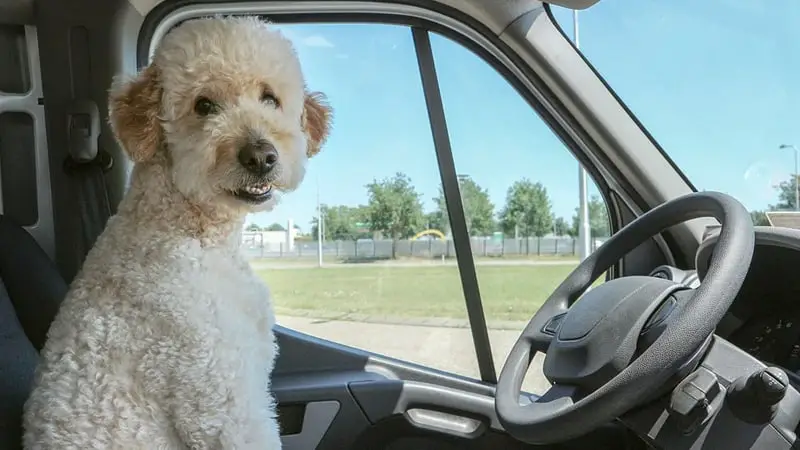Traveling with pets is a challenging, and sometimes exciting experience. But when temperatures get very unfriendly, the experience starts to get a lot less unfriendly. If the temperature conditions aren’t stellar, you should generally avoid traveling with your pet, and here’s why.
Most pets, including dogs and cats, are all at risk of hypothermia and hyperthermia at extremely low and hot temperatures respectively. Traveling at either temperature without appropriate reservations can be consequential to your pet’s health in the long run.
Unless it’s necessary, it’s clear that staying away from traveling with pets in extreme weather conditions is ideal. However, there are times when it gets necessary, and this article will show you how to deal with those situations for the wellbeing of your pet.
What Happens to Animals in Hot Weather?

The human body is optimized to handle most weather conditions, and we’ve also invented various clothing and accessories to help in regulating our temperature. When temperatures get very hot, you can either sweat it or turn on the air conditioner for some cool air.
For dogs, cats, and most other pets, that is usually not the case. While their bodies also regulate heat naturally, their heat regulation system isn’t as efficient as that of humans, since they can’t change their clothing.
If you have a thick-furred dog, it will find it easier to keep warm during the winter than to regulate its temperatures in the summer. However, pets with little or no fur will need some help during the winter, as the cold can be excessive.
Of course, different animals deal with hot weather differently. Dogs are particularly bad at managing extremely hot weather since they’re almost totally covered in fur and they sweat through their skins.
To keep your dog healthy during a trip in hot weather, you must take active steps to ensure that your dog’s temperature is regulated artificially if they’re unable to do it themselves. Fortunately, this isn’t much of a hassle, and you’ll learn how to do so in a bit.
What Happens to Animals in Cold Weather
Granted, only a few people go on vacations in the winter, but people still do. If you’re part of the 23% of Americans that prefer winter vacations to summer ones, you may want to learn about the risks of exposing your pets to extremely cold weather.
Some dogs are specifically made to endure excessive cold because they originated from the colder parts of the world. If you have a Samoyed or a Siberian husky, you won’t have as much problem with cold as most other pets do.
Cats also deal with cold weather pretty well. However, they don’t have any answer to extremely cold weather. Once the temperatures start to dip under 45 degrees Fahrenheit, it becomes too cold, cats start to become vulnerable to cold-induced conditions.
In extremely cold weather, most animals experience hypothermia. Heightened hypothermia could stiffen the muscles, lower the heart rates, limit breathing, and very extreme cases, lead to death.
Sometimes, frostbite can also kick in. Frostbite is a condition where the skin freezes due to extreme cold, and it happens to dogs, cats, and a host of other house pets. However, this is a lot less common than hypothermia, but it’s also way more painful and damaging.
If your pet is elderly or has any underlying health symptoms, it can be even more tasking to regulate its temperature without help. This makes them more susceptible to hypothermia, and with the underlying symptoms found in most elderly pets, it’s usually deadlier for them than younger ones.
The simplest way to avoid all of these problems is by keeping them in a warm place and generally avoiding travel during extremely cold or hot weather. Sometimes, however, the trips are just necessary. This article will show you how to keep a dog healthy while traveling in grueling temperatures.
Tips for Traveling with Your Pet in Extreme Temperatures

If the weather is either too hot or too cold, you should try to keep your dog at home where its safe, unless the trip is absolutely necessary. But absolute necessity doesn’t ward away heat or cold; actions do. Here are some things to do before and after any trip to ensure your dog doesn’t suffer the risk of either hypothermia or hyperthermia.
1. Prepare your car for the trip
Before thinking of carrying your pet in your car in an extreme weather, you must ensure that your car is duly prepared for the trip. In hot situations, this means ensuring the AC systems work properly and the cooling is sufficient to keep the dogs stable.
If the temperatures are freezing cold, check to confirm your car’s heater is working properly. If your pet’s experience in the car is nothing to write home about, you may just be taking it for the worst trip in its entire life.
2. Pack relevant supplies for the weather condition
If it’s freezing cold, you want to make sure you’re not exposing your dog to all of the cold, even with a car heater. You can’t keep your car on all day, and when you stop to take a rest, a dog or cat sweater can help keep your cats warm until it’s time to go again.
If you’re traveling in hot conditions, you should try packing bottles of frozen water before the due date. Due to the severity of the heat, the frozen water will ensure that all of your pets have cold water to drink throughout the trip.
3. Plan the trip ahead
It doesn’t matter how much supplies you pack or how well your car is optimized for traveling during the harsh weather, your pet will inevitably be exposed to some degree of heat or cold during the trip. Therefore, you should make preparations to either cool off or warm up your dog or cat.
If you’re making any stops along the way, ensure it’s at a pet-friendly place. If it’s an hotel, check if they have reservations for pets to help you care for your pet before it’s time to get going again.

